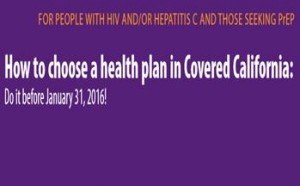 LOS ANGELES —Five leading California HIV organizations—Access Support Network, AIDS Project Los Angeles, Los Angeles LGBT Center, Project Inform, and San Francisco AIDS Foundation—have released an updated guide for people living with HIV, hepatitis C (HCV), hepatitis B (HBV), and individuals considering pre-exposure prophylaxis (PrEP) on choosing a health insurance plan through Covered California. The guide contains two parts. The first part explains important things to consider when choosing a plan and includes information about additional benefits that might be available to help pay for the cost of health insurance. The second part includes an analysis of the availability of HIV, HCV, HBV, and PrEP drugs on each of the 12 plans’ drug formularies.
LOS ANGELES —Five leading California HIV organizations—Access Support Network, AIDS Project Los Angeles, Los Angeles LGBT Center, Project Inform, and San Francisco AIDS Foundation—have released an updated guide for people living with HIV, hepatitis C (HCV), hepatitis B (HBV), and individuals considering pre-exposure prophylaxis (PrEP) on choosing a health insurance plan through Covered California. The guide contains two parts. The first part explains important things to consider when choosing a plan and includes information about additional benefits that might be available to help pay for the cost of health insurance. The second part includes an analysis of the availability of HIV, HCV, HBV, and PrEP drugs on each of the 12 plans’ drug formularies.
For individuals living with HIV, HCV, HBV, or considering PrEP, it is important to understand all of the options available before enrolling in a new health insurance plan through Covered California. A recent analysis by Avalere found that some 2015 Covered California plans provided limited coverage for prescription drugs and had high out-of-pocket costs. Our analysis of 2016 Covered California plans found that coverage and cost-sharing for HIV, HCV, HBV, and PrEP drugs varies significantly among insurers. Thus, it is extremely important for individuals to review each plan’s formulary and associated out-of-pocket costs before selecting a new health insurance plan. In addition, because plans can change at any time, we recommend that individuals speak with a certified enrollment counselor or certified insurance agent who understands their individual health needs before making a final decision.
Among the guide’s recommendations:
- People with chronic conditions and routine medication needs, including PrEP, should avoid Bronze and Minimum Coverage plans. Despite their low premiums, these plans have high deductibles and out-of-pocket costs that are likely to make access to medications and other benefits unaffordable.
- People with incomes between 138% and 250% of the Federal Poverty Level ($16,243-$29,425 for individuals) should strongly consider Silver plans where they will be eligible for help with out-of-pocket costs. The exception is people living with HIV who qualify for additional help through the AIDS Drug Assistance Program (ADAP) and the Office of AIDS Health Insurance Premium Payment program (OA-HIPP) with incomes over 200% of the Federal Poverty Level who may have lower out-of-pocket costs by selecting a Platinum plan.
- Some Californians living with HIV can get their medications covered and/or additional help paying for their medications through ADAP. They may also be able to have their insurance premiums paid by OA-HIPP. People living with HIV are now eligible for these programs if their modified adjusted gross income does not exceed 500% of the Federal Poverty Level ($58,850 for individuals) based on family size and household income.
- For Californians interested in PrEP, there are now multiple financial assistance programs that may be able to help pay for the cost of the medication. These programs are supported by Gilead Sciences, Patient Access Network Foundation, and Patient Advocate Foundation.
- For the 2016 plan year, people who enroll in a Covered California health plan will pay no more than $250 per month for a 30-day prescription drug supply for Silver, Gold, and Platinum plans and no more than $500 for a 30-day prescription drug supply for Bronze plans.
- All Covered California plans are now required to maintain a dedicated prescription drug customer service line where current and prospective members can call for help and receive an estimate of the out-of-pocket cost for specific drugs.
The release of the guide coincides with the open enrollment period for Covered California which began November 1, 2015, and continues through January 31, 2016. However, if you would like your coverage to start January 1, 2016, you will need to enroll by December 15, 2015. After open enrollment, you can only enroll through a special enrollment period, which occurs if you have a “qualifying life event” such as loss of a job, birth of a child, divorce, or loss of insurance. If you choose not to enroll and don’t have other comprehensive health insurance, you may be required to pay a tax penalty.
The guide is available at www.projectinform.org/pdf/











